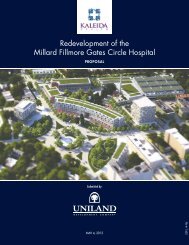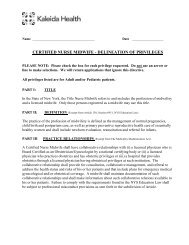Chromosomal Microarray Analysis: Taking a ... - Kaleida Health
Chromosomal Microarray Analysis: Taking a ... - Kaleida Health
Chromosomal Microarray Analysis: Taking a ... - Kaleida Health
You also want an ePaper? Increase the reach of your titles
YUMPU automatically turns print PDFs into web optimized ePapers that Google loves.
Deletion 1p36: A Recognizable<br />
Pattern of Malformation<br />
Most common terminal chromosomal<br />
deletion, occurring in 1/5000 live births<br />
Accounts for ~1% of cases of<br />
unexplained mental retardation<br />
2-3% of the general population has<br />
mental retardation, 50% of which have<br />
no identifiable etiology (genetic or<br />
environmental)<br />
Deletion 1p36: Growth and<br />
Development<br />
Postnatal growth deficiency (85%)<br />
Feeding difficulties: oropharyngeal<br />
dysphagia with failure to thrive<br />
Neurologic examination<br />
• Hypotonia (95%)<br />
• Seizures (45%)<br />
• Developmental delay (100%)<br />
• Severe to profound mental retardation with<br />
absent or very little speech<br />
Deletion 1p36 Phenotype<br />
Deletion 1p36: Other findings<br />
Craniofacial findings<br />
• Microcephaly (95%)<br />
• Large anterior fontanelle<br />
• Decreased AP dimension of the head<br />
• Straight eyebrows<br />
• Deeply set eyes<br />
• Flat nasal bridge<br />
• Minor ear anomalies (structure or position)<br />
• Pointed chin<br />
Cardiac defects (70%)<br />
Hearing loss (28%)<br />
5
















